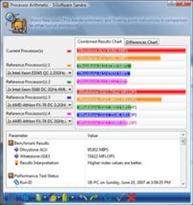Intel V8 Media Creation Platform - Dual Sockets - Dual Xeons
How we configured our test systems: When configuring our test systems for this article, we first entered their respective system BIOSes and set each board to its "Optimized" or "High performance Defaults". The hard drives were then formatted, and Windows Vista Ultimate 64-bit Edition was installed. When the Windows Vista installation was complete, we installed the drivers necessary for our components, performed a disc clean-up, disabled UAC, and set up a 2048MB permanent page file on the same partition as the Windows installation. Lastly, we enabled Vista's AERO interface, installed all of our benchmarking software, defragged the hard drives, and ran all of the tests.
![]()
HotHardware's Test Systems
AMD & Intel Inside!
|
|
|
We began our testing with SiSoftware's SANDRA XI, the System ANalyzer, Diagnostic and Reporting Assistant. We ran six of the built-in subsystem tests that partially comprise the SANDRA XI suite with the Athlon 64 X2 6000+ ( CPU, Multimedia, Multi-Core Efficiency, Memory, Cache, and Memory Latency) . All of the scores reported below were taken with the processors running at their default clock speeds of 3.0GHz.
The SiSoft SANDRA results presented above are a mix of good and bad. The processor arithmetic tests that can reside completely in L2 cache allow the 8-cores to run flat out, which results in some extremely high performance in those tests - nothing in SANDRA's database can touch the V8 here. Inter-Core and Cache bandwidth are also very high with this platform, but it does falter in regard to raw memory bandwidth and latency. The V8 rig barely broke the 6GB/s mark in the bandwidth test and its access latency was the highest of the bunch.













